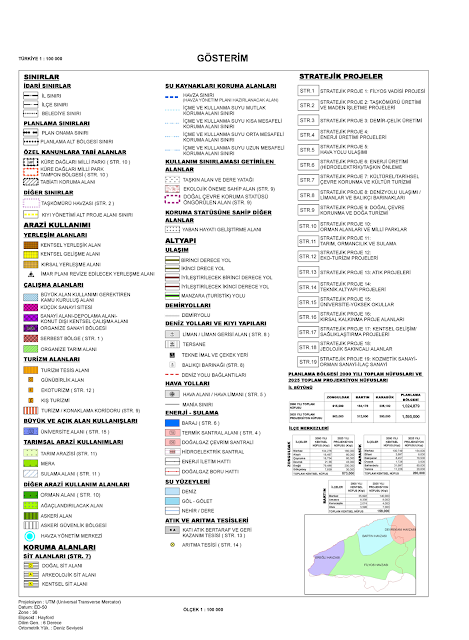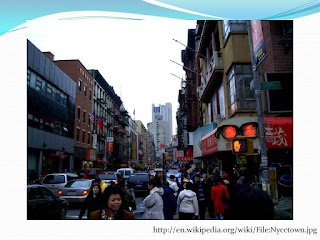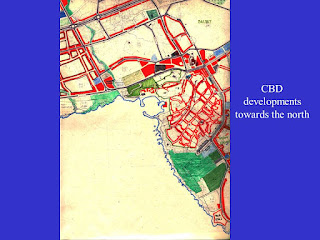Bu Blogda Ara
29 Aralık 2011 Perşembe
Little Italy & Chinatown (2)
Etiketler:
ChinaTown,
Little Italy,
New York
26 Aralık 2011 Pazartesi
ENVIRONMENTAL MASTER PLANS FOR PRESERVING NATURAL AND CULTURAL ENVIRONMENT: THE ZONGULDAK, BARTİN AND KARABUK PLANNING REGION
 |
| 1/100000 scale Environmental Master Plan of Zonguldak, Bartın, Karabük Planning Region |
Environmental Master Plans for Preserving Naturaland Cultural Environment: The Zonguldak, Bartın and Karabük Planning Region
Arda Yalçuk1 and Mehmet Tuncer2*
1Abant İzzet Baysal University, Faculty of Engineering and Architecture, Departmentof Architecture, Gölköy, BOLU
2 Abantİzzet Baysal University, Faculty of Engineering and Architecture, Department ofEnvironmental Engineering, Gölköy, BOLU
*Corresponding Author
ABSTRACT
Thisstudy discusses the scenario, strategies and policies to be developed for thepreservation of the natural and the cultural/historical environments which areof significance in the 1/100000 scale Environmental Master Plans prepared bythe Ministry of Environment and Forestry in recent years through the case of Zonguldak,Bartın, Karabük Planning Region for which the plan was completed in 2007.
Thisstudy discusses the scenario, strategies and policies to be developed for thepreservation of the natural and the cultural/historical environments which areof significance in the 1/100000 scale Environmental Master Plans prepared bythe Ministry of Environment and Forestry in recent years through the case of Zonguldak,Bartın, Karabük Planning Region for which the plan was completed in 2007.
Keywords: Environmental master plan, preservation, naturalenvironment, historical sites, strategy, policy.
1. AIM AND SCOPE
The Environmental Master Plan for theProvinces of Zonguldak, Bartın and Karabük (ZBK) (1/100000) estimates theeconomic, demographic and spatial development pattern within the sub-region ofWestern Black Sea Region by taking particularly into consideration the newinvestments an developments in the mining, energy, irrigation, tourism andagricultural sectors. The authors were project coordinators for this planprepared by UTTA Planning, Design and Consulting, Ltd. and Jeotek Ltd. between2005 and 2007.
Similar tothe strategic planning approach, general strategic estimations were made andmain decisions were taken in the plan regarding the natural, cultural andhistorical environment, social and economic sectors, spatial systems and thenearby settlements. Within the scope of this study, upper-scale sub-regional plandecisions were taken into consideration with more detailed spatial references andtheir effects on the nearby settlements were investigated. Accordingly, withinthe boundaries of plan area, the aim of the Environmental Master Plan of theProvinces of Zonguldak, Bartın and Karabük is:
to assessurban and rural development to ensure sustainable development, take measures toprevent migration and to ensure economic development in the planning region, assessthe developments in the mining, industry, agriculture, services, tourism and transportationsectors, establish the use-preservation balance by preserving water resourceson a watershed basis, agricultural lands and forests, determine the strategic and land usedecisions to ensure sustainability, make use of natural, historical andcultural environment for cultural tourism and eco-tourism, and to establish abasis for the large scale plans, (Tunçer et al, 2006).
The goalin the ZBK Planning Region is to strengthen the economic structure of theregion and to further create new employment opportunities, to raise the incomelevel and ensure capital accumulation in the region, to promote socialsolidarity by preventing out-migration and reducing the intra-regionaldifferences and to mobilize the resources of the region. Moreover, the mainstrategy is the integrated management of natural environment and water resourceson a watershed basis.
2. AN OVERVIEW OF THE ENVIRONMENTAL PROBLEMS IN THE PROVINCES OF ZONGULDAK,BARTIN AND KARABÜK
The environmental problems in the provinces ofZBK, according to the Environmental Status Provincial Reports used in thepreparation of the Environmental Master Plan and the Environmental Reports preparedby the planning group, are as follows (Demirci, 2006; Environmental Status ProvincialReports).
2.1. Environmental Problems in Zonguldak Province
2.1.1. Water Pollution
Zonguldakis an industrial city with heavy industrial facilities. Water pollution in theprovince is at significant levels. The reason for pollution in the surface waterresources in Zonguldak Province Zonguldak Province
 |
| Ereğli Planning Concepts of Environmental Conservation |
Chemical analyses were conducted atsix points to determine the level and extent of current pollution in Filyos Creek.The analysis results of Yenice Creek showed high levels of heavy metals,firstly iron and secondly manganese. The reason for such high parameters of ironand manganese is the KARDEMIR facilities that discharge the wastewater withouttreatment to Yenice Creek. The pollution in Yenice Creek reduces the quality ofwater as it merges with Filyos Creek. According to the analyses of the samples takenfrom other points from Filyos Creek, it was observed that the parameters ofheavy metals zinc and iron, of sodium, among cations, and, among the otheranalyzed parameters, nitrite nitrogen were high. Thus, the discharged domesticand industrial wastewater contaminate Filyos Creek, Yenice and Devrek Creeksthat merge with this creek, and Alaplı and Gülüç Creeks and Acılık River
The mountainous and ruggedtopography of the province and the scattered pattern of settlements result in alack of or a partial service of sewage systems in the area. Most of thewastewater collected by the municipalities that have sewage systems in theprovince is discharged to the surface water resources largely without being subjectto any treatment. Zonguldak is one of the provinces with the highest CODcontent in the sewage water in the Black Sea Region. The level of nitrogen inthe sewage system of Zonguldak Province
2.1.2. Air Pollution
In Zonguldak Province Zonguldak Province Zonguldak Province
Oneof the most important causes of land pollution in Zonguldak Province
2.2. Environmental Problemsin Bartın Province
2.2.1. Water Pollution
The most important factor causingpollution both in surface water resources and groundwater in Bartın Province Bartın Province
2.2.2. Air Pollution
Air pollution monitoring stations arenot yet established in Bartın Province
2.2.3. LandPollution
The causes of land pollution in Bartın Province
There is currently no storage areain the province and the solid waste collected by all the municipalities is irregularlystored in the stream beds and vacant sites. The solid waste collected in theprovince is mostly discharged in the stream beds. There are heavy industrialfacilities that cause air pollution in the organized industrial zone (OIZ). Ingeneral, the industries located in the OIZ are plastic, furniture, PVC doorsand windows, textile, food and paint industries. Fuel oil, coal and liquidfuels are used in the OIZ.
2.3.Environmental Problems in Karabük Province
2.3.1. WaterPollution
The main surface water resources in Karabük Province Yenice River and Yenice River together with Devrek Creek form Filyos River Karabük Province Karabük Province , except for the centraldistrict municipality and Municipality of Safranbolu , the domestic wastewaterfrom all the district and town municipalities is discharged into Soğanlı andAraç Creeks and the tributaries of Yenice River Karabük Province merge into Yenice River , which then forms Filyos River Filyos River and consequently contaminates the Black Sea .
2.3.2. Air Pollution
2.3.3. Land Pollution
In Karabük Province
All the district and town municipalitiesin Karabük Province
 |
| Legend of the Zonguldak, Bartin, Karabuk Environmental Master Plan 1/100 000 |
3. PRESERVATION OFTHE NATURAL, HISTORICAL AND CULTURAL ENVIRONMENT BY A STRATEGIC PLANNINGAPPROACH IN ENVIRONMENTAL MASTER PLANS
3.1. Understandingthe Environmental Potential and Decision-Making on Watershed Basis
The State PlanningOrganization (DPT) has so far adopted the provincial administrative unit.However, due to environmental problems and the processes influenced by theconcept ‘sustainability’, currently the watershed scale is taken as thebasis in the ‘sustainable regional growth (or development)’ studies. The RegionalDevelopment Specialization Commission Report (DPT, 2000) states that the mostappropriate ‘Regional Planning Strategy’ that could eventually reduce the inter-regionalsocio-economic disparities, the decisions that prioritize the centers andsectors, thus rendering these centers and the prioritized sectors the drivingforce of development, and the decisions considering these sectoral and regionalpriorities should be made on a watershed basis.
The aim of preparing plans on awatershed basis at a regional scale and in watersheds covering severalprovinces and river basins is shaped by the economical and rational utilizationof especially the limited fresh-water resources (underground and surface)considering the increasing water needs, the necessity of knowing the use areasof these resources according to a watershed plan in order to make use ofwater and effectively use the water resources (SKKY, 2004), the necessity oftaking precautions in the upper watersheds to protect the coastal areas, the possibilityof ameliorating the low-quality water resources - given the economic and technicalfeasibility -, the necessity of determining the suitability of the currentquality of the water resources to the quality criteria of the use areas, andthe possibility of better protecting the forests, agricultural lands and the biodiversitythat constitute these with the planning decisions made on a watershed basis.
Another aim of planning at a watershedscale is to determine the internal relationships and watershed capacity values ofthe natural resources in the three watersheds in Zonguldak, Bartın and Karabükand the effects of the human intervention on the environmental values of thewatersheds, and to investigate the demands that will occur on the naturalresources in the watershed, facilities and certain services.
Parallel to the plan at a watershedscale, it is aimed to develop a monitoring and evaluation system. The developmentof this system would be an important task of the Ministry of Environment andForestry and of the other central and local administrations following thepreparation of the Environmental Master Plan. The planning stages are composedof data collection, identification of aims and strategies, taking land usedecisions, and evaluating and monitoring the outcomes of the implementation.
With the land use decisions, it should be aimed to establish a balancebetween the environmental assets of the watersheds and the development trendsof the settlements through determining the natural areas to be protected (agriculturalareas, forests, vegetation, etc.) and the areas inappropriate for settlement(slopes, geological hazardous areas, such as landslide areas) and taking intoconsideration the social and economic structure of the settlements located inthe watersheds (Tunçer et al., 2006).
4. GOALS, SUB-GOALS AND STRATEGIES OF THEENVIRONMENTAL MASTER PLAN FOR THE PROVINCES OF ZONGULDAK, BARTIN AND KARABÜK
4. 1. Environmental Goals
‘Environmental preservation’ should be the maingoal in the environmental master plans (EMP) to be prepared. Ecologicalfeatures and natural resources should be adopted as the main resources foreconomic and social development.
‘Environmental Goals’ should be addressed, examinedin detail and assessed in the first place in a plan where environment is theprimary input. For this end, the Environmental Goals of the EnvironmentalMaster Plan are listed below. These goals, together with the sub-goals anddesign criteria, are explained below (Tunçer et al., 2006).
4.1.1. Protection of Water Resources
Protection of water resources will be accomplishedthrough the prevention of pollution of biological diversity and water resourceson which this diversity depends in the ZBK Planning Region, appropriatedisposal, recycling and elimination of solid and liquid waste, protection ofnatural assets, rendering these assets utilizable and maintaining them for thefuture.
4.1.2. Protection of Surface Water (sea andartificial lakes)
Sea pollution in Zonguldak and Bartın is at extremelevels in some parts. It is important to protect the current artificial lakes andthose planned and under construction in the western part of the Black SeaRegion, which often is damaged due to the floods and overflows. Thus, it isnecessary to take measures in the coastal area against pollution caused by itshinterland, control land development and ensure that the extent and the degreeof development do not negatively affect the flora and fauna of these areas.Therefore, Coastal Management Projects are significantly strategic projectsproposed in the plan.
4.1.3. Protection of Groundwater Resources
The surface and underground water resources shouldbe determined and protected scrupulously in the planning region. Waterresources bear an important potential for the prevention of water-relatedcrises in the future. Another increasingly influential factor causing waterpollution is the disposal of solid and liquid wastes from the urbanized areasand the industrial facilities to the surface and underground water sources inthe region. Moreover, it is known that artificial fertilizers that cause landpollution penetrate into water resources through irrigation or rainfall. It isan important environmental goal to protect groundwater resources, ensure theirsustainability and to prevent pollution.
4.2. Goals Regarding Environmental Problems
4.2.1. Prevention of Water Pollution and WaterQuality Improvement
Prevention of sea pollution and pollution of waterresources of vital importance in the planning region, improvement of thequality of water resources through elimination of pollution and maintainingthis quality constitute an approach appropriate to the importance andsustainability of water resources. In addition to the current legal measures,this issue is determined as an important goal to define the measures to betaken with the EMP (Tunçer, 2006).
4.2.2. Solid Waste Collection, Recycling andElimination
There are important initiatives in order tocollect, recycle and eliminate particularly urban solid waste in the planningregion. The municipalities collaborate for the establishment of a commonlandfill facility. The collection, recycling and elimination of solid waste isan important environmental goal of the EMP and the related strategies aredeveloped.
4.2.3. Liquid Waste Collection and Treatment
Rapid realization of the ongoing projects oftreatment facilities for liquid waste, which is the most observable andproportionally the largest pollutant, was set forth as one of the mostimportant goals that could pioneer and encourage the accomplishment of othergoals. Moreover, this issue is considered a ‘Strategic Project’ in the plan.
4.2.4. Prevention of Air Pollution
It is identified that the industries with outdatedtechnology located in the city centers of especially Zonguldak and Karabük andthe low-quality coal used in residential areas increase air pollution. Measuressuch as preventing over-population in areas where air currents cannot beeffective and ensuring the use of natural gas in all the settlements are takenas decisions in the EMP. Especially through increasing the use of natural gasin residential areas and workplaces air pollution could reduce air pollutiongradually. In addition, the plan suggests effective measures be taken for theprevention of air and water pollution caused by the ERDEMİR and KARDEMİR facilities.
4.2.5. Prevention of Land Pollution
The irregular use of artificial fertilizers forenhancing the efficiency of land is a rather important cause of land pollution.Besides, the limited amount of the ‘Absolute Agricultural Lands
4.2.6. Prevention of Pollution Caused by IndustrialPlants
The pollution caused by the mining activities andthe port in Zonguldak, and by ERDEMİR in Ereğli, and KARDEMİR in Karabük is significant. There are few treatment facilitiesin the Organized Industrial Zones in the planning region. In order toaccomplish the goal of preventing the pollution already caused and will becaused by the industrial plants, pollution caused by the current plants shouldbe prevented and the proper functioning of the systems in the treatmentfacilities should be ensured, as the land is inadequate and expensive, and theenvironment should be protected.
4.2.7. Use of Alternative Renewable EnergyResources (hydroelectric, wind and solar energy)
Using renewable alternative energy sources is animportant goal that would support environmental protection and the reduction orelimination of different types of pollution (Göksu, 1993). An important strategy of the EMP is the use of the wind andsolar energy potential especially in the coastal parts of Bartın as anincreasingly popular alternative energy resource. The utilization of thehydropower resources through the use of the potential of the water resources inthe region is of great importance. This issue as well is proposed as a‘Strategic Project’ in the plan.
4.3. Goals Regarding Ecosystems
4.3.1. Developing plan decisions for theprotection, improvement and recreational use of the forests in the planningregion
The forests constitute approximately 64% of theZonguldak, Bartın and Karabük Planning Region. The forests are protected by theForestry Law. Abandonment of or land development in the areas between forestsand the abovementioned woodlands due to inefficiency, would have a negativeimpact on the green areas. It is an environmental goal to protect the forestsand the trees in the forests, regardless of their species.
4.3.2. Protection of Flora and Fauna
Flora and fauna are one of the most importantelements among the ‘Environmental Assets’. Preservation of ecological balanceis possible through protection of flora and fauna. Thus, a goal towardsprotection of environmental assets is not sufficient in general and flora andfauna should be taken into consideration within a separate goal.
4.4. Goals Regarding Urban, Archaeological, Naturaland Cultural Assets
4.4.1. Protected Areas
Development Plans for Conservation should beprepared in accordance with the principles of preservation and terms of use,restrictions on land development, rehabilitation, renovation, theimplementation phases and programs, the design principles regarding open spacesystems, pedestrian circulation and vehicle transportation and infrastructurefacilities, density and plot designs, local ownership and financing theimplementation of the project.
STRATEGY 7: CULTURAL AND HISTORICAL ENVIRONMENTALPROTECTION AND CULTURAL TOURISM
It is suggested that the outdated ‘DevelopmentPlans for Conservation’ be reconsidered and put in practice. For thesustainable protection and development of Safranbolu, which is in the list ofWorld Heritage Cities, cultural tourism should be planned by considering theenvirons of the city and together with Yörük Village Safranbolu Yörük Village
.
5. Discussion and Conclusions
A ‘Watershed Management Model’ is proposed as theprimary planning approach for the Environmental Master Plan of the ZBK PlanningRegion (1/100000). Watershed management will be based on the processes ofnatural resources of natural regeneration and sustaining their generations andthe aim will be determining the use-preservation balance. In addition, it isplanned to tackle and assess the historical and cultural assets and the urbanand archaeological protected areas by means of strategic projects. ‘IntegratedNatural Resource Management’ is defined as “the planning , development andmanagement of the sustainable use of the natural resources by considering themain principles of ecology in a catchment basin to ensure the social, culturaland economic development of a society”. This approach is an important method totake into consideration during the upper-scale planning stages. A plan which ismore applicable, feasible, flexible and protective for the watersheds could beprepared by utilizing the abovementioned method in the future EMPs. Sustainableregional development could take place with the application of the strategies atsub-scales and the preparation of the related programs, plans and projects.
6. REFERENCES
1. Devlet Planlama Teşkilatı (DPT), “Özelİhtisas Komisyonu Raporu, “Bölgesel Gelişme” (The State PlanningOrganization, Special Commission Report, ‘Regional Development’), DPTPublication No: 2502-ÖİK:523, Ankara,67–78, 2000
2. Zonguldak,Bartın, Karabük İlleri, İl Çevre Durum Raporları, (The Provincial Environmental Status Reportfor the Provinces of Zonguldak, Bartın, and Karabük) 2004-2007, Ministry ofEnvironment and Forestry.
3. Göksu, Ç., “Fosil yakıtlar bizi kirli ve karanlık bir dünyayasürüklüyor. Biz bu kötü gidişten güneşin sevgi dolu tertemiz enerjisikurtarabilir mi” (Fossil fuels are dragging us to a dark and dirty world. Could the lovingclean energy of the sun can save us fromthis ill course of events?), METU, Faculty of Architecture, 1993.
4. Su Kirliliği Kontrol Yönetmeliği(WaterPollution Control Regulations), 2004.
5. Tunçer, M., , Zonguldak, Bartın, Karabük Planlama Bölgesi1 / 100 000 Ölçekli Çevre Düzeni Planı Plan Açıklama Raporu (DescriptiveReport for the 1/100000 Environmental Master Plan of the Zonguldak, Bartın,Karabük Planning Region), Jeotek and UTTA Aralık 2006.
6. Uzel, A., Zonguldak, Bartın, Karabük Planlama Bölgesi 1/ 100 000 Ölçekli Çevre Düzeni Planı Plan Araştırma Raporu, Giriş Bölümü (ResearchReport for the 1/100000 Environmental Master Plan of the Zonguldak, Bartın,Karabük Planning Region), Jeotek and UTTA, Aralık 2006
7. Demirci, E., , Zonguldak, Bartın, Karabük Planlama Bölgesi 1 / 100 000Ölçekli Çevre Düzeni Planı Plan Araştırma Raporu, Çevre Bölümü (ResearchReport for the 1/100000 Environmental Master Plan of the Zonguldak, Bartın,Karabük Planning Region, Environment Chapter), Temmuz 2006
Etiketler:
Environmental master plan,
historical sites,
natural environment,
policy,
preservation,
strategy






























































































































